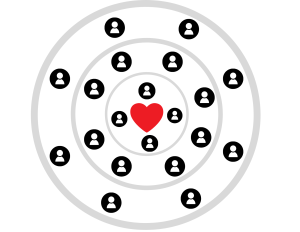Supporting and caring for an individual living with a brain injury can leave both you and the survivor feeling isolated and alone. This may not be the case at first. While your loved one is in the hospital or when they first come home, people are dropping by to visit; food is being dropped off at home; and people are calling and texting for updates.
As time goes by, this often changes. You may realize your social circle, and the social circle of your friend or family member, has decreased significantly since the injury. The offers of help fade away, and you may be facing the daunting task of having to handle their care on your own.
People need the support of others, particularly when it comes to situations such as caring for someone with a brain injury. And you may have more support than you realize – you just need to take some time and visualize the whole network.
When you develop a circle of care, you build a network of people you know you can count on for support for yourself and your loved one.
An easy way to think of your circle of support is to draw a circle with you (or your loved one) at the centre. Depending on your situation, you may have multiple levels of support, with people to help your loved one or people to help you.
To develop your circle of support, you need to see which level is appropriate for each individual on your support team.

Inner circle
The inner circle is usually those closest to the person with the brain injury or you. These are the people they rely on most and are more intimately involved in recovery and care. This is most likely where you would be when developing a circle of care for the person with the brain injury.
Other members of the inner circle of support/care can include:
- Parents
- Spouse/partners
- Children
- Siblings
- Close friends
These are the people that you may ask to help you with some of your caregiving should you need assistance.
Middle circle
The next layer in the circle of care would include people who are involved in the person’s life, but perhaps not on a day-to-day basis. There may be a broad range of people in this circle. Examples include:
- Aunts and uncles
- Grandparents
- Friends and their spouses or partners
- Neighbours
- Family friends
- Spiritual/faith-based supports
- Peers or classmates and their families
- Colleagues
Outer circle
The outer circle is made up of people and organizations that may not be used daily but can still be relied upon for support. These can include:
- Local business owners
- Community groups
- Community brain injury associations
- Community support organizations (for example: meal delivery)
Formal support members
The circle of support can also include more formal supports such as paid caregivers. Depending on where the person is in their recovery, a formal support member may be in the middle circle (such as a case manage or personal support worker), or the outer circle (like a psychologist or family doctor).
The following people could be considered formal supports:
- Doctor
- Nurse
- Physiotherapist
- Occupational therapist
- Social Worker
- Case Manager
- Speech-Language Pathologist
- Psychologist
- Chiropractor
- Lawyer
The circle of support is for both survivors and caregivers
While the circle of support is designed for the person with a brain injury, it’s also for you. If you are the primary caregiver, you are going to have a lot of responsibilities and much of your time will be devoted to your friend or family member. While caregiving is rewarding, it can also be stressful. It’s important that the primary caregiver has a support network that can assist them when they need respite. This is where the circle of support comes in handy.
Identify your circle of support
To help identify the circle of support, list all the people who have been in their life and have shown interest in maintaining a relationship or helping. You can also include people that have offered to help you with caregiving.
Identify areas where help is needed
Having a list of the tasks or activities where you may need support is helpful to have on hand. Break the list up into different categories such as daily tasks, weekly tasks, or occasional tasks.
The individual person and your relationship with them will determine where they fit in your circle of support. If they can help with smaller occasional things such as picking up your mail; dropping off a meal; driving you to appointments; or fixing a broken item in your home, they may belong in your outer circle. If the person can help with things that happen more often such as activities of daily living (ADLs), they may belong in your inner circle.
Fostering your circle
It’s important for your circle to come together and understand how important they are to you/the person with a brain injury. If you choose, you could introduce members of your circle to each other. By doing this, you are turning your circle of support into a true community.
You can also foster your circle by helping people understand what you and the person with a brain injury need.
There are several resources that may be helpful for those in your inner circle:
- Your local brain injury association may have support programs in place
- The University of Sydney has some free resources as part of their TBI Express program, designed to help people with brain injury and friends/family/caregivers with communication
We all need people who can support us and building a circle of care is one of the best ways to ensure that you and the person with a brain injury get the support and compassion needed.
